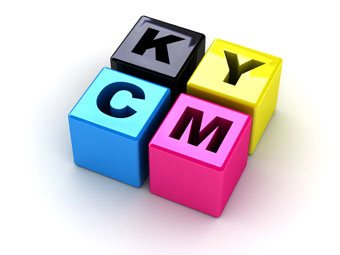First of all, here is an explanation of what they mean:
CMYK
CMYK refers to the four ink colors used in process color printing: Cyan (a light blue), Magenta (a pinkish red), Yellow, and Black. In 4-color printing (process color), all of the colors you see are made up of combinations of dots in these four colors.
RGB
RGB stands for Red, Green, Blue. These are the colors you see when you look at images on your computer screen or at photos taken with your digital camera. The colors are made up of a combination of these three hues. In process color printing, these colors need to be converted to CMYK.
Pantone
Pantone Colors refer to a color matching system (Pantone Matching System or PMS) where inks are made into specific colors which are then printed in a color-matching swatch book. Some process colors are difficult to achieve through process printing (especially oranges and some greens), so using a pantone color ensures a perfect and consistent color match. Jobs can be printed on 5- or 6-color presses using the four process colors plus one or two spot (pantone) colors in order ensure an exact color match.
Important Differences to Know
It’s important to recognize one of the major differences between CMYK and RGB. CMYK colors work by “subtracting” or absorbing light reflected from a white piece of paper. With no ink on the paper, all of the light is reflected back to the eye and the paper appears white.
RGB colors, on the other hand, are additive colors. Your computer monitor is black and light is added to produce color. White is produced when all three colors are added at a density of 100%.
Due to the two different color standards, colors will appear very different on your monitor than they will on paper after being printed. And too, no two monitors illustrate color exactly the same, which further complicates color design and printing.
Because what is seen on the monitor is not the same as the printed page, designers often use PMS colors as a standardized point of reference. Then, depending on whether the piece will be used on the web or as a printed piece, they convert the pantone colors to RGB or CMYK. For printed jobs with a color that needs to be an exact match, that color is kept as a pantone color and treated as a 5th color on press. This does, however, increase the price because of the extra plates, set-up time, and wash-up time. The need for an exact color match should be weighed against the extra cost.
So, to summarize, CMYK, RGB, and Pantone refer to three different types of color standards used in the design and printing industries. While it may sound confusing at first, it makes sense to those who work with it on a regular basis. Let your printer know if you have questions about the right way to use these color standards and they’ll be glad to help you.




Leave a comment